Alexander Green has been sharing investing ideas with Oxford Club subscribers for over 20 years, and I recently joined his flagship newsletter, The Oxford Communiqué.
In short, the Oxford Communiqué is an investment newsletter focused on helping subscribers build long-term wealth through the stock market.
Getting started costs $49 or more (depending on how you join), and as a subscriber, you get monthly newsletters, weekly updates, stock picks, and numerous learning resources.
Is it worth it?
This newsletter may not suit everyone, and it’s certainly not a “get-rich-quick” thing, but after trying it out myself I have come to the conclusion that, yes, it is worth it.
That’s not something I usually say about these services because many of them are overhyped or, in some cases, scams. And there are some “cons” to consider. But Alex Green’s newsletter is legit and will likely interest long-term value investors.
Ahead, I’ll show you everything I learned about the service to help you make a more informed choice, including a glimpse at how the model portfolio is doing.
What Is The Oxford Communiqué?
The Oxford Communiqué is an investment newsletter service run by the Oxford Club, and it’s headed up by the company’s “Chief Investment Strategist,” Alex Green.
According to the welcome letter you receive upon joining, the goal of the service is to help subscribers learn how to beat the “broad market returns” while also limiting risks, reducing taxes, and maximizing income.
“… our mission at The Oxford Club is to help you learn how to maximize your income, minimize your taxes, double the broad market returns, minimize market risks and, most importantly, live a financially free life without money worries or concerns.”
– Alex Green
There are five model portfolios within the member’s area, which contain over three dozen stock and ETF recommendations Alex Green has shared with subscribers.
And while his picks don’t seem to follow a set “theme” in terms of sector or market cap, Alex Green’s approach is essentially that of a value investor.
When sharing his stock ideas, he breaks down the company’s industry, business model, revenue and profit growth, market valuation, and dividend (among other things).
And the point of all of that, from what I can tell, is to recommend what he believes are genuinely great and potentially undervalued businesses.
Here’s how Alex Green summed up his approach in a recent newsletter:
“To put money to work in a market as volatile as this one, you need to know the company well. You want to understand the business. You want to see sales and earnings growing rapidly. And, ideally, you also want a low valuation and a high dividend.”
As a subscriber, you get Alex Green’s latest investment ideas via the newsletters and model portfolios, and from there, you can decide if you want to follow those ideas or not.
You also get training and resources that show you how everything works, so even if you’re a beginner, you will know exactly how to follow his ideas if you want to.
Who Is Alex Green?
Alexander (Alex) Green is the guy behind the Oxford Communiqué newsletter and several other services the company publishes, including The Momentum Alert, The Insider Alert, Oxford Microcap Trader, and Oxford Centurion.

According to the Oxford Club website, Green became the Oxford Club’s Chief Investment Strategist in 2001, but he seems to have joined the company before that.
Based on what I found by sleuthing through the newsletter archives, the earliest mention of Alex Green was actually in a December 2000 “mid-month” edition of the Oxford Communiqé newsletter called “The Chairman’s Letter.”
However, in February 2001, he was featured front and center of what appears to have been the very first “main” edition of the newsletter, which at the time was called “The Oxford Club Communiqué.” And interestingly, back then, he was referred to as “C.A. Green.”
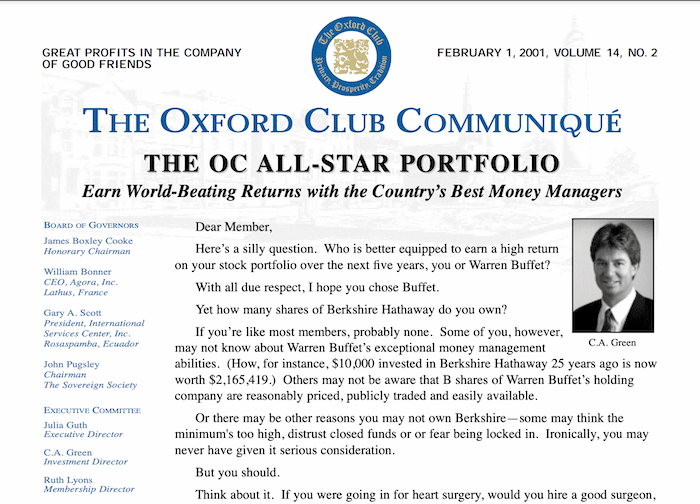
I don’t know what the deal is with that… but C.A. Green was later changed to C. Alexander Green (in an October 2002 newsletter), and now he’s known as Alexander Green.
Is he the real deal?
Green says he spent 16 years on Wall Street as an investment advisor, research analyst, and portfolio manager. And while I wasn’t able to verify that (since he hasn’t shared any specifics online about who he worked for), he does seem legit.
Why do I say that? Well, for one thing, you can tell he’s knowledgeable just by reading his newsletters and the free articles he shares on a blog called Liberty Through Wealth. He has also authored four “bestselling” books, all of which are well-reviewed on Amazon.
Furthermore, he seems to have a decent overall track record in terms of his stock picks.
And I use the word “seems” because it’s difficult to know for sure.
On the one hand, Alex Green’s “open” (active) recommendations in the model portfolios are doing quite well. I’ll elaborate on this shortly, but there are multiple double and triple-digit winners in the portfolios at the time of writing this. Awesome.
But on the other hand, the Oxford Club doesn’t give you a full breakdown of the service’s winning and losing picks since inception, which makes it very difficult to properly evaluate Green’s track record when it comes to this service.
Also, while the Oxford Club claims that the Oxford Communiqué has been “ranked as one of the 10 top-performing investment letters in the nation for the last 15 years” by the Hulbert Financial Digest, I was unable to find that “ranking” anywhere online.
From what I can tell, the only ranking on this service from the Hulbert Financial Digest is on the following page, which only started tracking the service’s results in 2022:
That said, I did manage to find a kiplinger.com article that shows that Alex Green’s service had a solid track record in the five years leading up to 2007, and the source the article listed was the Hulbert Financial Digest.
Here’s a snippet to show you what I’m talking about:
“… The club’s semi-monthly newsletter, the Communiqué, has performed impressively. On average, its portfolios gained 16% annualized over the past five years to January 3, according to the Hulbert Financial Digest.”
– 2007 Kiplinger article
My point?
While it’s unclear how well the Oxford Communiqué has performed since inception, it does appear that, at the very least, Alex Green has picked some decent stocks over the years and has helped his followers see decent gains during certain periods of time.
And as mentioned, I’ll show you how his current model portfolios are doing shortly, which should give you a better idea of how his picks have worked out.
In any case, what you learn simply by reading Green’s monthly newsletter issues, research reports, and weekly updates is enough to show that he’s a knowledgeable investor. So if nothing else, chances are you will learn a lot by subscribing to his newsletter.
Joining the Oxford Communiqué
As with other Oxford Club newsletters I’ve looked into, there are three price tiers with the Oxford Communiqué service: $49, $79, and $129.
Each membership is essentially the same but comes with different bonuses (like special reports, for example), and they all automatically renew after 12 months.
Another thing I learned after joining is that there’s a “Pro” version of the Oxford Communiqué, which costs up to $200 extra per year.
I didn’t “upgrade” to that service, but it’s essentially a beefed-up version of the one I’m reviewing that comes with extra content and an extra model portfolio.
In any case, to join the service, you can either visit the Oxford Club website and sign up through the default link at the “regular” price (which is $249), or you can join through one of Alex Green’s stock teaser presentations, which normally lets you join for $49.
Long story short, I chose the $49 option.
And after skipping past a “lifetime subscription” upsell ($544), I wound up in the member’s area, which I’ll walk you through now.
Inside the Member’s Area
As I pointed out in my review of another popular Oxford Club subscription called the Oxford Income Letter, the page you land on when you first join an Oxford Club service is littered with ads. Pretty much everywhere you look, there are ads pitching their services.
But it’s pretty easy to skip all that and navigate to what is essentially the “home page” of the Oxford Communiqué service, which gives you everything you need to get started.
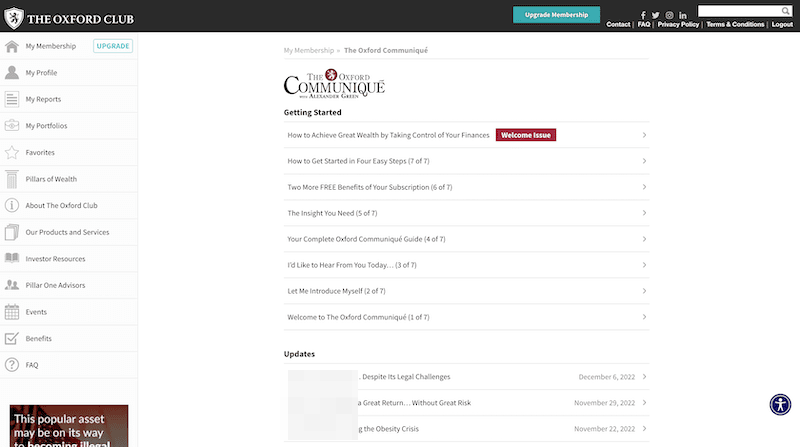
Here’s a quick overview of what you’ll find on this page:
- Getting Started: This section, which you can see in the above screenshot, consists of a “welcome issue” and a seven-part getting started guide. The idea of these resources is to help you familiarize yourself with the service before getting rolling.
- Updates: The updates section contains weekly content written by Alex Green that covers any changes or important updates to his existing recommendations.
- Issues: This part of the page provides you with an overview of the latest newsletter issues, which are the main component of the service (more on this shortly).
- Portfolios: The model portfolios (of which there are five) show you what investments Alex Green has recommended that are still “open” (i.e., stocks he hasn’t recommended selling yet).
- Reports: There are almost two-dozen research reports you can access in the member’s area that show you why Alex Green likes some of the companies and assets he’s recommended and basically give you insight into his investment philosophy.
- Other: Aside from all that, the members’ area contains a bunch of training resources in the form of videos and text aimed at helping subscribers learn Green’s strategy. This includes a video on asset allocation to help you build your own portfolio.
There’s a lot of content available for subscribers, but that’s the gist of it.
And the two main aspects I think most people are going to be interested in are the newsletter and portfolio. So let’s discuss those now.
Overview of the Monthly Newsletter
The monthly newsletter is easily one of the best aspects of the Oxford Communiqué service, as it’s where Alex Green shares his latest investment insights and stock picks.
Green usually begins by discussing the broad market dynamics playing out and then relates that to a stock or ETF he’s interested in and why.
For example, this month (December 2022), he talked about his view on inflation, rising interest rates, and the possibility of a recession. And then he talked about a “luxury business” he’s bullish on that he believes can do well despite all of this.
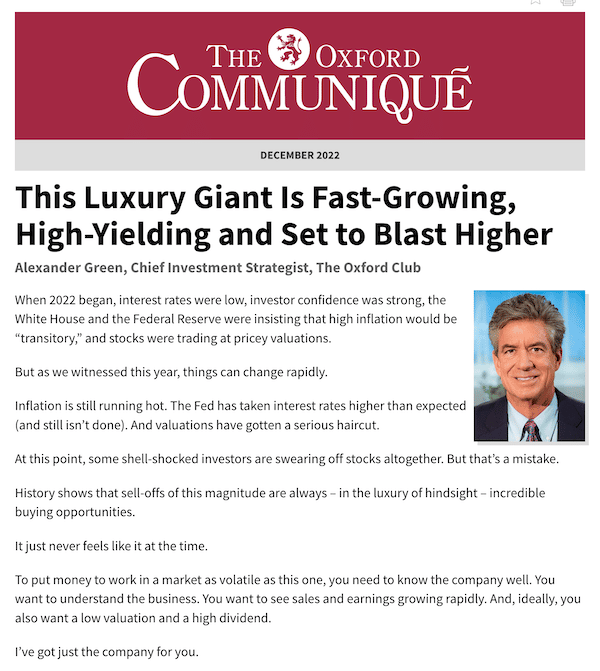
Other than talking about the company’s industry, revenue, dividend, and valuation metrics, Green also talks about what the “smart money” is doing regarding his pick.
In other words, he shares his research on what large investors and company insiders are doing with respect to the companies he recommends.
All in all, Alex Green provides quite an in-depth take on each recommendation, which will no doubt interest those who like to do their research before jumping into anything.
And he usually highlights a new stock or ETF each month, depending on what his research has uncovered at any given time.
Anyway, that’s the gist of the first main section of the newsletter.
However, there are several other sections worth noting as well:
- Building Wealth: This section is usually from someone other than Alex Green, but it varies from month to month, as do the topics it covers. For instance, this month, the Oxford Club’s “Senior Markets Expert” Matt Benjamin, discussed the broader market and global economy. Whereas other times, Quantitative Strategist Nicholas Vardy has shared his take on the market. The general idea is that this section provides you with market insights from people other than Alex Green to give you a different perspective.
- Beyond Wealth: This part of the newsletter is not about building wealth per se. Instead, it’s about developing better habits, how to think like a successful person, and things of that nature. I guess you could call it personal development but with an investment focus. Green also shares book recommendations in this section.
- Portfolio Review: This section gives you a comprehensive update on some of Alex Green’s existing portfolio recommendations. It’s quite comprehensive, too. Instead of just giving you some generic updates on his picks, Green goes into detail on why he still likes these companies and how his thesis ties in with the current market dynamics.
At the end of each newsletter, you also get a “snapshot” of how the model portfolios are doing and any changes that have been made (i.e., buy and sell recommendations).
You can see a “semi-live” (daily updated) version of the portfolios in a different part of the member’s area, but the portfolio “snapshot” at the end of each newsletter is still useful.
Why? Because the regular portfolio page doesn’t show you Alex Green’s “sell” recommendations, so sleuthing through the newsletter archives can be useful if you want to see how his past picks have worked out over time.
So, that’s exactly what I did.
And in the next section, I’ll show you exactly what I found.
The Oxford Communiqué Model Portfolios
There are currently five model portfolios that Oxford Communiqué subscribers get access to inside the member’s area, and each caters to different investment goals.
Here’s a quick summary of each portfolio:
- Gone Fishin’ Portfolio: This, according to the Oxford Club website, is the “core portfolio” of the Oxford Communiqué service. Alex Green even wrote a book called The Gone Fishin’ Portfolio. So it’s a central part of his overall strategy, and he describes it as a “simple but sophisticated long-term investment system” in the member’s area.
- The Oxford Trading Portfolio: According to Green, this is an “active and diversified portfolio of the market’s most compelling opportunities.”
- The Oxford All-Star Portfolio: This portfolio is made up of a diversified basket of funds and holding companies that Alex Green says are “managed by some of the world’s top-performing money managers.”
- Ten-Baggers of Tomorrow Portfolio: As the name suggests, this portfolio consists of companies that Alex Green thinks have the potential to “rise tenfold or more.”
- The Fortress Portfolio: Lastly, Green says he’s designed this portfolio to “reduce your risk and boost your profits in any market.”
As I mentioned earlier, there are currently over three dozen recommendations in the model portfolio, which are mostly a mix of U.S. stocks and ETFs. However, Green’s picks also include international stocks, bonds, and real estate investment trusts (REITs).
There is a set percentage allocation Alex Green suggests following, too.
It’s called the “Oxford Asset Allocation Model,” and it basically shows you how he recommends constructing a diversified portfolio.
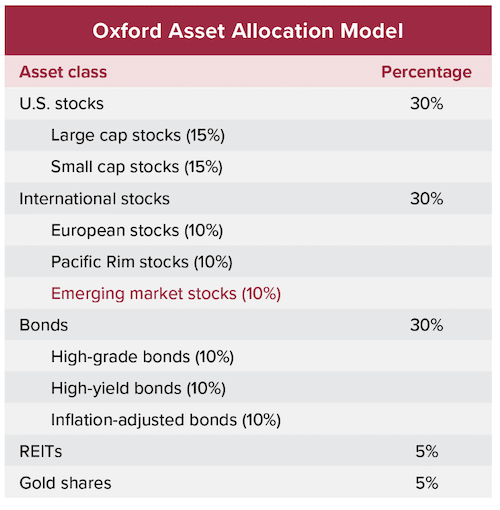
How have the recommendations performed?
The “open” (active) recommendations are doing really well. There are many single, double, and triple-digit winners throughout the five model portfolios.
The following are some screenshots I took of these portfolios, which show you how they have done from inception to December 7, 2022.
Just know that the “Gain/Loss” column can change daily (or thereabouts) because these are all active positions, so this is not a very reliable way to gauge the service’s performance, especially since it doesn’t show you the “closed” picks.
Gone Fishin’ Portfolio:
The Oxford Trading Portfolio:
The Oxford All-Star Portfolio:
Ten-Baggers of Tomorrow Portfolio:
The Fortress Portfolio:
As you can see, there are some losing picks in the mix, which is to be expected. But overall, this is one of the best-performing “open” portfolios I’ve seen to date.
Take that with a grain of salt, though.
Because it’s really the “closed” recommendations that matter most, and the Oxford Communiqué doesn’t make it easy to find this information.
As mentioned earlier, the Oxford Club provides a “snapshot” of the portfolios at the end of each newsletter, which can be useful, but unless you’re willing to dig through over 20 years worth of newsletters (which quite frankly would be insane) it’s not possible to get a complete picture of the service’s overall performance.
That said, I did do some sleuthing and found the following “sell” recommendations that Alex Green has published since 2019 (possibly longer).
And all except for one are down double-digit percentages:
| Time period | Percent gain/loss |
|---|---|
| August 2019 | -22.2% |
| December 2021 | -40.3% |
| January 2022 | -17.3% |
| February 2022 | 25.78% |
| May 2022 | -44.2% |
| June 2022 | -30.7% |
| June 2022 | -31.8% |
Those aren’t very flattering results, which may explain why finding this stuff is such a chore.
But there are still lots of solid picks in the “open” portfolios.
And who knows how many winning sell recommendations you’d find if you went back even further through the newsletter archives.
Either way, the past performance of any newsletter is not a reliable way to predict how it will work out for you in the future because the market is unpredictable.
What I’ve shared should help give you a better idea of the Oxford Communique’s picks, but how it works out for you will depend largely on when you join, what picks you follow, and how each recommendation works out, which is impossible to predict.
Is the Oxford Communiqué a Scam?
The Oxford Club puts out a lot of different advertisements to promote the Oxford Communiqué newsletter, and some of them are overhyped, but it’s not a scam.
For $49 (or $249 if you pay the full “retail” price), you get a ton of in-depth content in the newsletters, research reports, weekly updates, and training guides.
And Alex Green has recommended some great stocks.
So, while there is no guarantee that the service will help you make money, let alone help you become wealthy, it is a legitimate newsletter and one I personally think is worth it.
That said, I did find some complaints about the Oxford Club, which mostly seem to relate to the company’s marketing practices and billing system.
Basically, due to the sometimes sensationalist marketing, some people join services like this expecting to get rich overnight, which obviously isn’t real, and that can lead to complaints.
And the company automatically bills you after 12 months, which some people either aren’t aware of this or simply end up forgetting over time.
What about getting a refund?
Well, not being able to obtain a refund is another common complaint, it seems. But not so much for the Oxford Communiqué itself, as this service comes with a 60-day refund policy.
Instead, these complaints seem to relate to other services the company sells.
See, what the Oxford Club does, which is very common in the newsletter space, is that it offers a refund on its entry-level newsletters but doesn’t always provide one for its higher-priced services. And that seems to be what catches many people off-guard.
You’d think the company would have a consistent refund policy across the board, but that’s not the case. Often, you can only get a “refund credit” on their high-ticket services, which can sometimes run well into the $1,000s.
In any case, the Oxford Club has been around for over 30 years and is one of the more well-known publishers in the space. And while I’m not a huge fan of their sales tactics and billing/refund system, its Oxford Communiqué service is legitimate.
Pros and Cons
Pros:
- Alex Green has a unique approach to evaluating potentially undervalued companies and does a great job of breaking down his thesis in the newsletters and reports.
- Subscribers get access to buy and sell recommendations, the reasons behind them, and a detailed asset allocation guide, which makes following Green’s ideas a sinch.
- There is an abundance of relevant, in-depth content in the member’s area that covers Alex Green’s ideas, market outlook, investment approach, and more.
- The stock picks appear to have done pretty well overall.
- $49 for 12 months is a great price.
Cons:
- I have always thought that Alex Green is one of the less “spammy” stock pickers out there and that the Oxford Club is a cut above the others. But from the overhyped presentations and pushy upsells to the spammy ads in the member’s area and annoying emails you get… it’s pretty obvious that the company’s goal is selling as much as possible.
- As with the majority of newsletter services I’ve encountered, I think the Oxford Club could be more transparent with subscribers about how the stock picks have performed overall. As in, there should be a page that clearly shows you the Oxford Communique’s entire track record (winners and losers) in one simple chart.
Bottom Line
Whether or not the Oxford Communiqué is something you’ll like will depend on your investment goals, preferences, and timeline, among other things.
But I personally think it’s one of the better newsletters out there.
Given my reservations about some of the ads I’ve seen for the service, I am somewhat hesitant to recommend it. But I do like this newsletter and think that for anyone interested in long-term value investing, having a diversified portfolio, and generally just learning from a knowledgeable investor like Alex Green, it’s well worth a look.
That’s my take, anyway.
If you want to know more about Alex Green’s stock picks before deciding, then you might find my research on the different stock teaser presentations he’s released helpful, as I’ve uncovered a bunch of his stock picks on this site.
For example, I recently uncovered his “#1 stock for 2023,” which was part of a pitch for a different service he runs called Oxford Microcap Trader.
I’ve also uncovered his “single stock retirement play” pick, which has been teased as both a “$3 stock” and “$4 stock.” And I recently uncovered his top LNG pick.
So you might find those helpful if you want to further your research.
Also, I recently reviewed a different Oxford Club service called the Oxford Income Investor, which, as the name suggests, is focused on income investing.
That’s not my top pick either, but it could be a decent alternative to the Oxford Communiqué if you’re looking for a service that focuses more on dividend stocks.

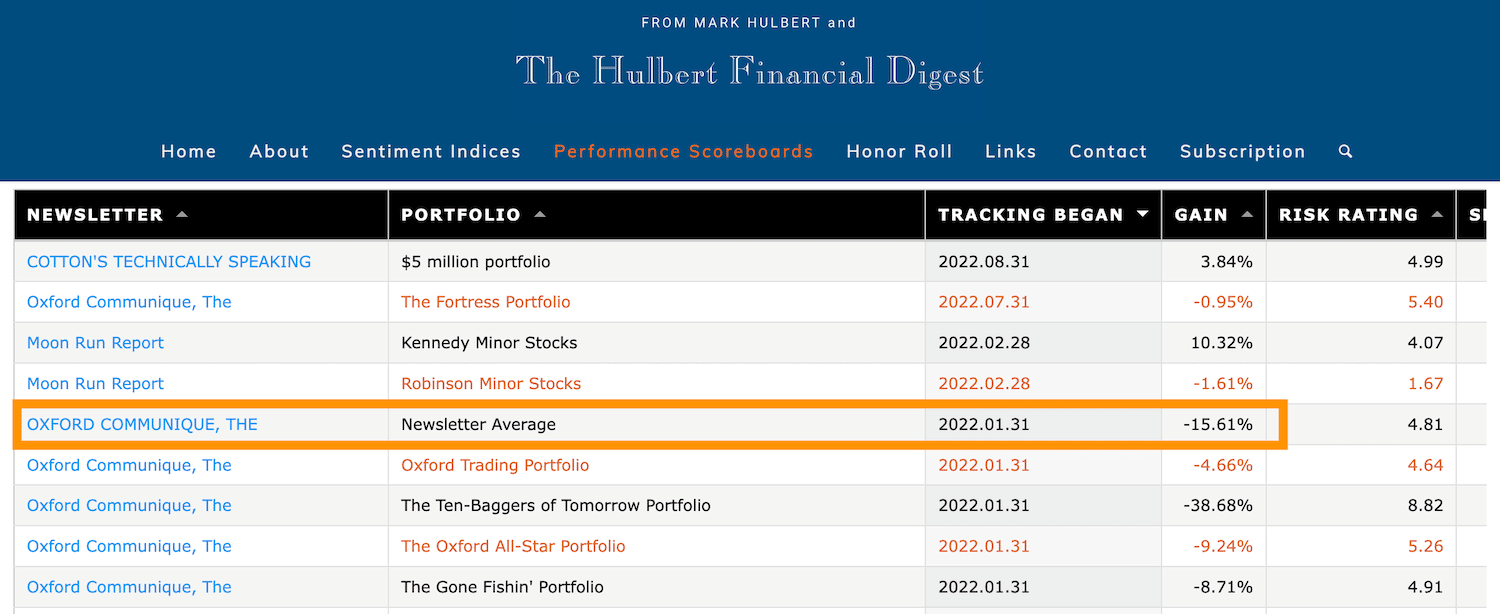
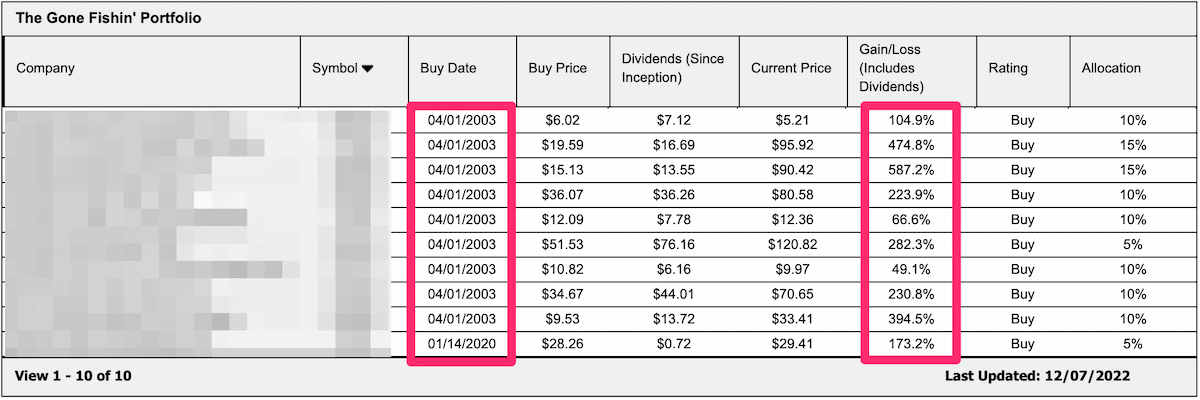








I am a Lifetime member of The Oxford Club at the Director’s Circle Level. I receive both the Communique and the Income Report. I have made some real good money on Alex’s advice. Look he has had dogs but with his 25% stop loss rule from the highs my losses were not deadly. [unlike Motley Fool which states hold for 25 stocks for5 years min – Disney done nothing in a decade and they put a buy rating on Upstart at $300 and rode it down to $70 (that take a return of 320% to get to break even) I could go on and on with FOOL]. As with all my investments I do my own research and technical analysis with Fibonacci numbers.
These people were good to me at first, but later they cheated me. In total, I was scammed out of nearly 55,000 euros. The first contact was with the administrator of the platform. He contacted me, cheated me and convinced me to make more and more deposits. I knew all the time that something was wrong, but he kept telling me to relax, that he had everything under control, and in reality he lied to me all the time. Eventually he made up the story that he had been in a serious accident and was in the hospital. When he got out of the hospital, he was replaced by another administrative assistant, who of course told the same story in a different scenario. We worked for two months when he again asked to invest a package of 15,000 euros with the intention that the bill would not die and I panicked and paid only because of the money we had invested. It took a week and he asked for another 7,000 euros to stabilize the account, to which we disagreed, and I asked him to return the money. He openly refused and laughed at me. It took me months of searching, but finally I found the solution of a expert who got back all my money, Feel free to reach to (jimbianco189 @ gmail. com) If you have the same issue, I only filed a complaint and got my money back within 2 weeks
Thanks for the great review of the Oxford Club. I have been a member for a number of years. For the low price of membership I think it is a great value. They also have another very good expert, Marc Lichtenfeld, who I follow and is pretty accurate with his selections. I did get a cash refund recreantly of $995 and they were very nice and understanding about my problem. I would say they are one of the best info companies for day traders today. Thanks again for your information. Regards, Paul
My pleasure, Paul. Glad it helped.
Yeah, I am familiar with Lichtenfeld. I actually ended up joining his entry-level service, the Oxford Income Letter. Admittedly, I am somewhat skeptical of The Oxford Club in general, given their marketing campaigns, but I would say that the services I’ve joined are pretty decent for the price.
Anyway, thanks for the comment, and all the best!
Hi Tim ! I admire your work reviewing different paid trading services. I have read your review on Strategic Trader. What options alert service would you recommend ? I start using now Theempiricalcollective.com. Is there a better one ? Many thanks !
Hi Robertin,
Great, glad you have found the site useful, and thanks for the comment!
I don’t really recommend any options services, so I can’t really help you with that question. I may review more of those types of services in the future, but my personal preference is long term investing (not trading), so those are the types of services I tend to focus on.